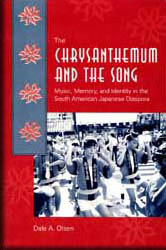 Gainesville: University Press of Florida, 2004.
Gainesville: University Press of Florida, 2004.
Music helps form and nurture ethnic identity for large populations of people of Japanese descent in Argentina, Bolivia, Brazil, Peru, and Paraguay. In a story never before told, Dale A. Olsen offers a musical history and ethnography of this vibrant Asian diaspora, the largest population of overseas Japanese in the world and one of the most successful subcultures in South America.
An early immigration of Nikkei–people of Japanese heritage–landed on the coast of Peru in 1899. Hundreds of thousands more arrived in the first half of the 20th century, most seeking work as agricultural laborers. Olsen argues that music became essential for nourishing their “Japaneseness,” perhaps second only to speaking the Japanese language. Music making, music listening, and dancing all express the soul of the people and tell others who they are, he says. Communicated and transmuted through the intricate workings of collective memory, music has the power to reconstruct and manipulate cultural identity; it helps immigrants maintain strong connections to their ancestral home and to forge new ones in their adopted culture.
Olsen provides a history of Nikkei emigration and music from the Japanese homelands, comments on the contributions and the roles of song contests and karaoke in shaping their new social life and identity, and discusses Nikkei aesthetic values. His research sources include interviews, memoirs of immigrants and their children, newspaper accounts of Nikkei musical experiences and thoughts, and observations of musical events. Olsen also documents and interprets his own performances with and for the Nikkei on the Japanese shakuhachi flute.
Covering five generations of Nikkei over more than a century, this ethnomusicological investigation makes an original contribution to Japanese diaspora studies. It will be of special interest to scholars of the sociology of immigrant cultures and identity formation, Asian and Latin American studies, and ethnomusicology. It offers a model of innovative theoretical and experimental ways to learn about subcultures in diaspora.
From the back cover of the book:
“A unique study of music in the lives of several generations of Japanese immigrants in Latin America. It applies both traditional and new technologies to the interpretations of new data.” — William P. Malm, emeritus professor of ethnomusicology, University of Michigan
Please “click” the following to read a detailed and knowledgeable review:
Linda Kinsey Spetter, in the Journal of Folklore Research
AUDIO EXAMPLES (see also pages xiii-xv in the book)

5 – Itsuki no Komoriuta” : Japanese lullaby performed by “Coral Ashibue,” directed by Ken’ichi Yamakawa and accompanied by Tomoi Inoki and her five koto ensemble, Tomoi-Kai, in concert in São Paulo, Brazil on July 12, 1981 (a Nikkei lady sitting next to me in the audience was constantly singing or humming off pitch along with the music).


10 – (currently not available) “Haru no Umi” : Japanese shinkyoku composition by Michio Miyagi. Performed by Tomoi Inoki (Yamada-ryu koto) and Dale A. Olsen (Western Flute) in concert at the University of São Paulo. August 20, 1981.
11 – “Tanko Bushi” : Japanese min’yo (folk song) performed by Akira Yamura (vocals), Dale A. Olsen (shakuhachi), live drummers providing the rhythmical accompaniment, and pre-recorded cassette tape that includes shamisen and guitar, during a Bon odori rehearsal with forty dancers, in Baurú, Brazil, on August 10, 1993.




16 – “Kojo no Tsuki” (not “Sakura,” as erroneously written in the book) : Japanese popular song, performed by Madre Magdalena Kanno (vocal and taishogoto) and Dale A. Olsen (shakuhachi) in rehearsal. Santa Cruz, Bolivia. March 29, 2001.


19 – “Shika no Tone” : Japanese shakuhachi honkyoku. Performed by Dale A. Olsen in concert. Centro Social Japonés. Santa Cruz, Bolivia. March 29, 2001.

21 – “Kumoi Jishi” : Japanese shakuhachi honkyoku. Performed by Dale A. Olsen in concert. Centro Social Japonés. Santa Cruz, Bolivia. March 29, 2001.